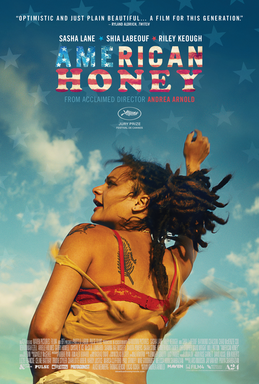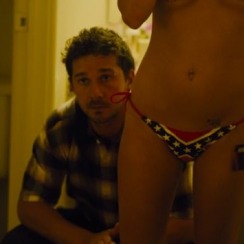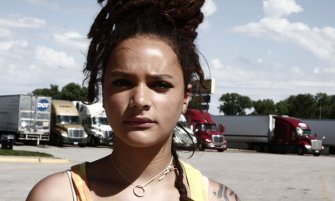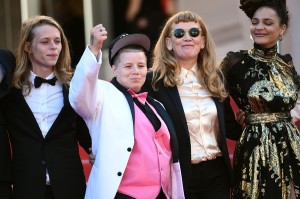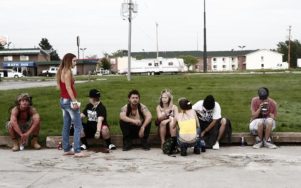Andrea Arnold’s American Honey is an exhausting ride. A road movie in which the genre, which is surely the ultimate expression of freedom and of America itself, is used to explore the hollowness or perhaps the overripe ideology that is ‘America’ . This is a landscape and a nation with icons still in place, road, cars, motels, seen from the back of a van by a group of stoner teens, hussling dollars from their fellow citizens . At one point the manager of the magazine subscriptions crew, Krystal (Danielle Riley Keough) Elvis Presley’s granddaughter, America’s original hill billy icon, tells her already run down workers that they’ve got to dress down like white trash and get the sympathy vote. This theme of exploitation, of dog eat dog, runs throughout the film, similar to Arnold’s Fish Tank, with parents neglecting children, adults pitted against youth, males preying on female, female to male. At the centre and the one who controls our gaze is the mesmerizing Star, (Sasha Lane) perhaps the American Honey of the title who in a great cinematic moment stands up in a Buick stolen from white Texan, Stetson-doning millionaires, and declares « I feel like I’m fucking America » her dreadlocks and her non-white face contained in the vast landscape. This is an adventurous image for a nation so perturbed by race and was featured on the poster, perhaps a first for a black woman in a film with America as its title ?
Escaping from an abusive father/ stepmother situation, Star stumbles across the rag tag teenagers when she catches Jake’s eye (Shia La Bœuf), the cocky leader of the mag crew in the Walmart and is lured into another kind of predatory relationship, here not only with Jake , but with the controlling female boss, Krystal, who keeps Star and the crew in tight check, enticing them with uplifting singalongs and booze but also creating the violent rules, those who make the least money have to fight. In a self consciously iconic scene, wearing a stars and stripes bikini, Krystal hs lotion massaged into her legs by the submissive Jake while she visciously puts down Star for not earning enough money, “You show me you can do it or i’m going to put you on the side of the road”. Krystal suspects that Jake and Star have indeed found love, which is something that the cash and the flash Mustang that she drives, can’t give her.
The exuberance of youth is never too far away and the moments of escape, another trope of the road movie, are what the film revels in, achieved through rambling scenes where music, drugs, dance, fighting and sex take over, when the job of selling the magazines is finished for the day. This is where the film is at its most powerful, where overall tone, rhythm and framing become the meaning of the film. Bodies fill the screen in a tight aspect ratio bringing the viewer right in on the action. The scene in which Star, whose quest for her own money compels her to sell herself to an oil worker for a grand, is set against a backdrop of flames, here money desire, sex and human relationships are all evoked in the mise en scene. It is also in the audio that the film captures a generation’s mood as they lip synch to their play list in spontaneous bursts of group dancing. Songs are repeated in the film without fear of boring the audience and used as a rallying call; “I like to make money get turnt” (Carnage), “I make my own money so I spend it how I like ” (Rae Stummard).
In the bus, in the parking lots they appropriate the musical language of black hip hop culture which contains a message for those with nothing, that only money and sometimes love will get you out. Rihanna’s trashy “We found love in a hopeless place” performed by Jake on top of a check out desk becomes Jake and Star’s song, featuring twice in the film, and even old white rock gets its moment. A truck driver plays ‘the Boss’ Springsteen and Star who says, “hey wait , I know this song” and sings along, connects American past and present. Music doesn’t just enhance the narrative but is the narrative. In the climactic scene music is blasted from the back of the van whipping up a frenzy of paganistic dancing over a fire and this, accompanied by manic camera and the chorus “we are the saviours”, makes the audience experience viscerally where this doomed generation of youth are headed.
Arnold as a female British filmmaker has taken on an incredible challenge, the ultimate baton of making an American film, daring to name it in the title and then turning it on itself. She examines film and nation through micro details; jelly baby’s stuck on the van window, chipped nail varnish, trapped insects, the film eschewing the grand vista and narrative for the oddities that go unnoticed. Alongside this is Arnold’s treatment of realism, the large cast made up of unknowns including Sasha Lane, was a major talking point of the film and as the credits roll it is the cast who are named as co-creators while the director’s name is absent. The blurring of fact and fiction is Arnold’s trademark, which aligns her with female filmmakers who also work with similar non-fiction strategies; Celine Sciamma’s Girlhood, Rebecca Johnson’s ,Honey Trap and Clio Bernard’s Selfish Giant. In these films it is the marginalised who are brought to the forefront and allowed to create their own representation. The potential for a transformative moment, to understand or experience something beyond the film itself in the viewer is created.
Feminist Film Stars: ***America through the eyes of a young woman
Bechdel Rating: Partial fail because there is little dialogue between anyone apart from Star and Jake,

